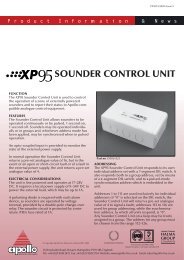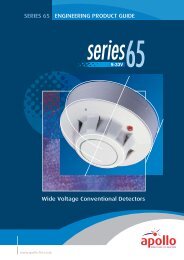Monitor 43 V1 (Page 1 - 2) - Apollo Fire Detectors Limited
Monitor 43 V1 (Page 1 - 2) - Apollo Fire Detectors Limited
Monitor 43 V1 (Page 1 - 2) - Apollo Fire Detectors Limited
Create successful ePaper yourself
Turn your PDF publications into a flip-book with our unique Google optimized e-Paper software.
The future is...flat<br />
<strong>Apollo</strong> has unveiled its latest innovation - the slimline Plateau ®<br />
fire detector.<br />
Plateau is the supermodel of the fire detection<br />
world. Its ultra-thin profile has been developed for<br />
applications where it is impractical or undesirable<br />
to use a standard smoke detector. Standard fire<br />
detectors can be seen by some architects as<br />
obtrusive, but specifying Plateau means that interior<br />
designs are not compromised by the 'lump on the<br />
ceiling'. Alternatively, the interior could be a heritage<br />
building with unique features that need to be<br />
preserved in appearance.<br />
The patented Plateau is flush-mounted and fits into a<br />
hole in the ceiling so that only the plastic cover plate<br />
is visible. The flat profile is possible because these<br />
smoke detectors do not have an internal smoke<br />
chamber - instead combustion products are detected<br />
outside the device itself.<br />
Plateau operates as an optical detector, but the light<br />
beam is transmitted through the cover plate and<br />
reflected by any smoke close to it. The light that is<br />
reflected is registered by a receiver in the detector,<br />
which will change to the alarm state if the presence<br />
of smoke is confirmed.<br />
8<br />
Features include permanent checking for<br />
contamination on the cover plate and automatic<br />
adjustment of the alarm threshold as required to<br />
compensate. The device will raise a fault condition if<br />
contamination is excessive. There is also an inbuilt<br />
self-test facility.<br />
Requiring its own DC power supply, the Plateau<br />
detector is connected to an XP95 or Discovery loop<br />
by means of a Zone <strong>Monitor</strong> or DIN-rail Zone <strong>Monitor</strong>.<br />
<strong>Apollo</strong> has also developed a special vandalresistant<br />
version of Plateau for applications<br />
where standard fire detectors could be a<br />
hazard. Examples include prison cells, detention<br />
centres and secure units in hospitals. This<br />
device features a 4mm stainless steel plate<br />
instead of the standard plastic cover, but is<br />
identical in other aspects to the standard<br />
version.<br />
Far left: Plateau – the future of<br />
fire detection<br />
Left: The vandal-resistant<br />
version of Plateau<br />
Below: The slimline Plateau<br />
will not compromise modern<br />
interior design<br />
<strong>Apollo</strong> has been chosen to protect<br />
Portsmouth Guildhall following a major<br />
review of fire strategy. The contract was<br />
awarded to Christie Intruder Alarms (CIA)<br />
Ltd, an approved supplier for Portsmouth<br />
City Council.<br />
The Guildhall is situated in the centre of<br />
Portsmouth and dominates Guildhall<br />
Square. Following extensive damage<br />
caused by bombing during World War II,<br />
the building was rebuilt during the 1950s.<br />
Today it is used as an entertainment and<br />
conference centre, as well as housing The<br />
Coroner's Office, the Council Chamber and<br />
Mayoral Suite.<br />
There were a number of challenges for the<br />
new fire system. In some areas, such as<br />
the Mayoral Chambers and banqueting<br />
facilities, architectural considerations<br />
precluded the use of standard hard-wired<br />
devices. There was also the need for<br />
flexibility, to cope with the multi-use<br />
nature of the site.<br />
Using <strong>Apollo</strong> technology, Christie Intruder<br />
Alarms was able to select products to<br />
deliver a fully compatible fire system that<br />
did not compromise on performance or<br />
reliability. <strong>Apollo</strong>'s analogue addressable<br />
XP95 and Discovery devices form the basis<br />
of the fire protection system.<br />
Some 600 XP95 devices were used to<br />
protect the main areas of the building,<br />
while Discovery ionisation detectors were<br />
used in areas where there was the<br />
possibility of smoke entrainment. Those<br />
installed at the Guildhall are set to Mode 4,<br />
so that their sensitivity levels are<br />
appropriate to the risk in these areas.<br />
Beam detectors were used in the<br />
auditorium roof void, high level plant<br />
rooms and the Council Chamber. For the<br />
heritage areas, Christie Intruder Alarms<br />
used <strong>Apollo</strong>'s wireless XPander range.<br />
A key switch facility enables the stage<br />
manager to switch the smoke detectors in<br />
the auditorium to 'heat only' mode when<br />
smoke generators are in use. Operating<br />
the key switch also isolates the high level<br />
beam detectors in the roof void. A second<br />
key switch facility controls the door hold<br />
open devices around the auditorium.<br />
The fire system is configured in 32 zones<br />
and controlled by an eight-loop Advanced<br />
Electronics MX 400 control panel. The<br />
system is monitored at the ground floor<br />
reception and by front-of-house staff<br />
during functions. Interfaced with it is a<br />
Scope emergency pager system that alerts<br />
designated staff if an alarm is raised so<br />
they can investigate incidents prior to an<br />
evacuation being initiated. <strong>Fire</strong> cover was<br />
maintained throughout the changeover.<br />
<strong>Apollo</strong> protects<br />
Portsmouth<br />
Guildhall from<br />
fire<br />
9













